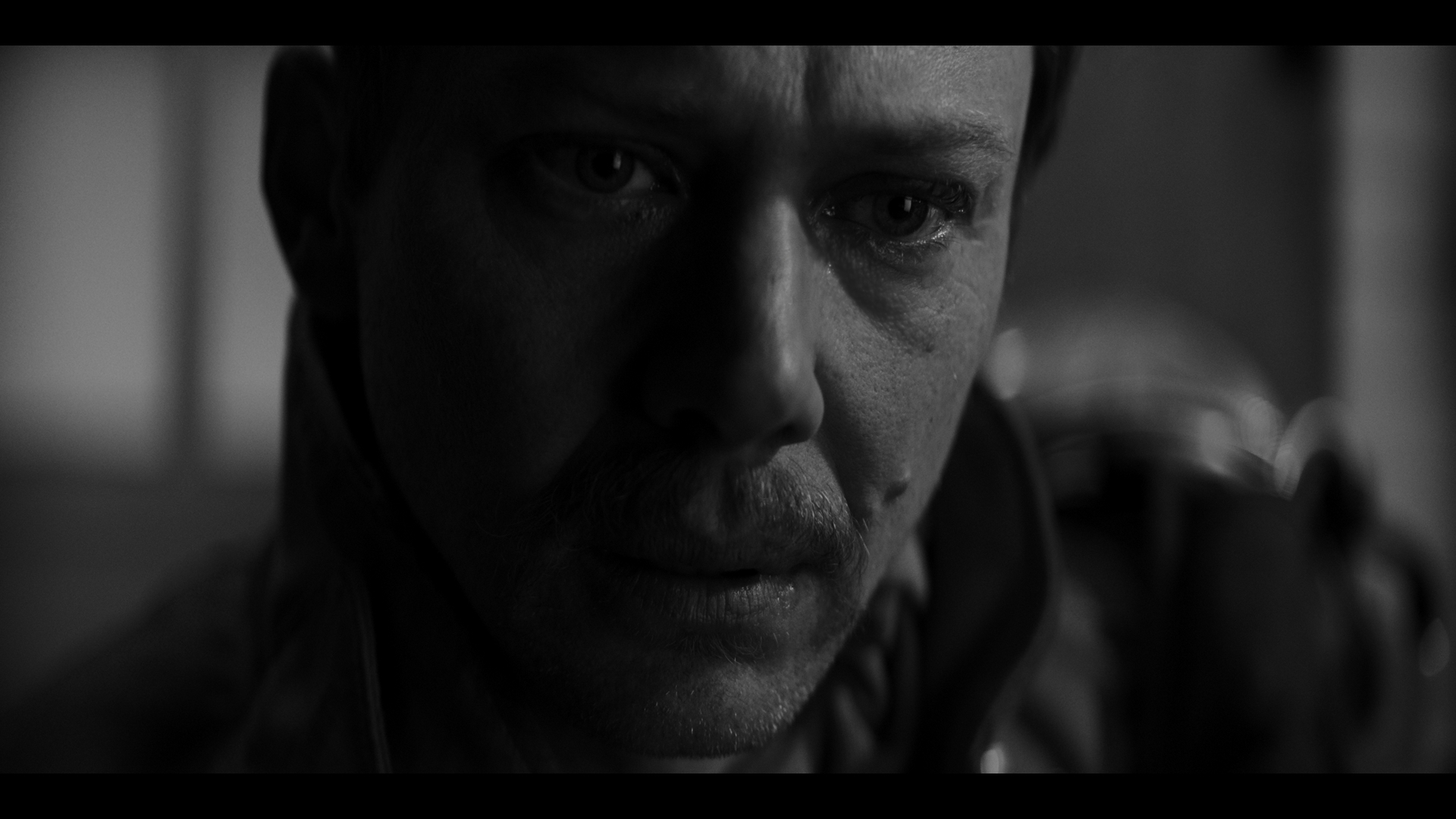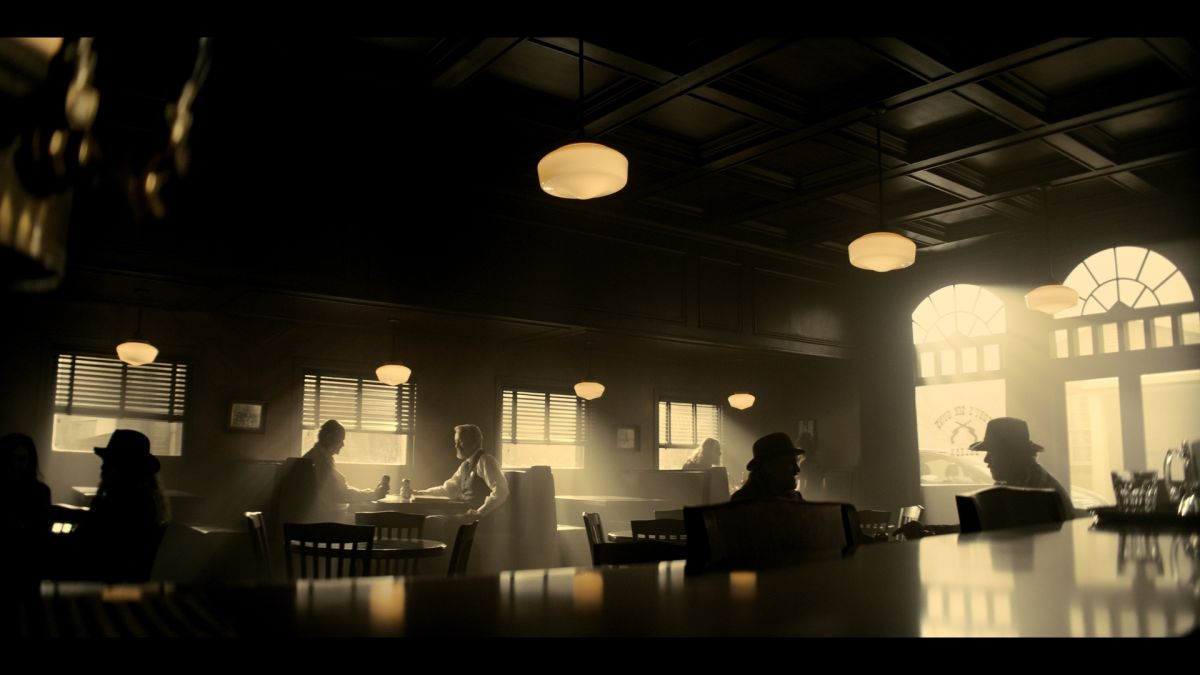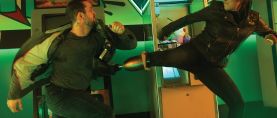
Perpetual Grace, LTD: Q&A With Nicole Hirsch Whitaker
The cinematographer discusses her Neo-noir Epix series — and her work that preceded it.
The cinematographer discusses her Epix neo-noir series — and her work that preceded it.
Unit photography by Lewis Jacobs. All images courtesy of Epix.
Perpetual Grace, LTD starts strong, then soars skyward. The show is a modern noir, flush with flared silhouettes, long takes and equally long shadows, and wide, slow-moving, low-angle push-ins. The story follows James (Jimmi Simpson), a disillusioned young man who attempts to cast a con artist’s net around fish far too big: Pastor Byron Brown (Ben Kingsley) and his wife Lillian (Jacki Weaver), good ol’ family folk who make their own living by sweeping up the life savings of their flock.
Created by Steven Conrad and Bruce Terris, the darkly comedic series premiered June 2 on Epix. Cinematographer Nicole Hirsch Whitaker was behind the camera for episodes 3 through 10 after her husband, James Whitaker, shot the first two episodes; James went on to direct episodes 3, 4, 7 and 8, with Conrad — who also served as showrunner — directing the remainder. After also wrapping the Apple TV+ series Truth Be Told and before setting off to shoot the Netflix series Jupiter’s Legacy in Toronto, Nicole Whitaker took time out of a coloring session to sit down with AC and retrace the career path that’s brought her to Perpetual Grace, LTD.

American Cinematographer: You’d previously worked with showrunner Steve Conrad on the series Patriot. Did you see any similarities between the two shows?
Nicole Hirsch Whitaker: The thing I love about Steve's shows — it was the same with Patriot — is that you almost have to go back and rewatch every episode. It's like when you're reading an amazing book and you have to reread the first chapter because so much happens [and] you can't wrap your head around it all.
Steve and Jimi [Whitaker] have a strong vision, and they created a beautiful template for both shows. Steve loves simple shots where a lot happens, and then complicated shots where people are still. We always created a shot list, but still, when I would come to work, I didn’t always know exactly what he was going to want to do that day. He is constantly creating storyboards and forming new visual ideas overnight, so we had many tools at our disposal. Most days we would carry a Technocrane or Grip Trix with a [stabilized] head. We always had a Ronin and a Steadicam, as well as other tools in the grip truck, thanks to Jim Shelton, our incredible key grip. This allowed Steve and I to create and carry out his vision on the day. But I love that when I see the show, it still feels very organic. Sometimes it's harder to get to that organic place unless you have those tools — and a wonderful line producer who understands why we need them, as well.
How would you describe your overall approach as a cinematographer?
Whitaker: The most important part of my job as an artist and storyteller is to make sure that my work is not only beautiful, but also relevant to the story that we are trying to convey. If the images don’t drive the words on the page, you will lose your audience — and if no one wants to see what we work so hard to create, then I haven’t done my job. One of my favorite ways to prepare for a job and get inspired is to rewatch my favorite films and remember what my favorite cinematographers shot.
What were some of your early influences?
Whitaker: In high school we had a great darkroom, and I started exploring fine-art photography. The reason I got into filmmaking was that my English teacher Jim Hosney taught us a combination of literature and film. One example is, he assigned us to read Moby Dick, and then he showed us The Conformist — that was the first film that made me want to be a filmmaker, as well as [Michelangelo] Antonioni’s Red Desert and The Passenger, which Jim also showed me for the first time. Then he showed us [Rainer Werner Fassbinder’s] Berlin Alexanderplatz, and that sealed the deal! Foreign films were pretty eye-opening for me as a photographer — those directors and cinematographers were creating imagery like I was as a photographer, but in a moving platform. My brain exploded. I was in high school, and I had never seen movies like that. All of a sudden I was like, ‘Oh, wow, there is art in film!’

What was your first job in the motion-picture business?
Whitaker: When I was 16, I worked on Far Out Man, Tommy Chong's movie. My dad was friends with Tommy and asked him if I could have a summer job. That was my very first job. From rolling prop joints in the art department to cinematography!
How'd you get from that first job to where you are today?
Whitaker: I went to film school at New York University, but I left and went to Italy to study art and photography. When I returned to NYU to finish my film degree, I got an internship with a commercial and music-video director, Victor Ginzburg. I ended up helping run his company with another intern; we'd both produce, and I would shoot and edit as well. Victor also worked for a big commercial company, N. Lee Lacy, so on large jobs I would get to be a PA and his assistant.
I started worked at N. Lee Lacy straight out of college, which I loved, but [the work was] away from the creative side of things. I ended up producing commercials and music videos for almost 10 years. Still, all of the directors I worked with knew I shot, so they'd send me off to shoot 2nd unit. One director I worked with, Morgan Lawley, would always have me shoot her Bolex footage. Another woman director who really helped me move forward was Anouk Besson. They both started hiring me as a DP and gave me the confidence to realize what I really wanted to do. When I was pregnant with my first child, I said, ‘I'm not going to produce anymore. When I go back to work, I'm just going to shoot.’
How did you make that transition?
Whitaker: There were many years of just having to break down the door to have people see me as a DP. I'd call and call, and shoot tons of spec work. Anytime anyone asked me to shoot anything, big or small, I'd be like, 'Sure, I'll be there!' I also always had great crew that really stood by me. They'd come and work with me for no money and lend me equipment because I'd worked with them as a producer for so long. People were always ready to jump, and I never could have made the transition without their help. I also had great agents who believed in me and gave me opportunities I never would have gotten otherwise.

What do you consider when selecting your crew?
Whitaker: I think what we do for a living is so much fun — we’re so lucky. I love going to work, and I love people. But even when you're having a great day, the work can be really hard. So having people who keep me happy and support me is so important. I'd rather hire someone with less experience if they have a good attitude. For the last couple of years, I haven't had a day where I was not happy to wake up and go to work.
Now that you have established yourself as a cinematographer, how do you decide when to say yes or no? Do you still try to say yes a lot?
Whitaker: Yes! I don't have as much time as I used to, but I'd love to shoot more shorts and PSAs and projects that make an impact on society. Still to this day, one of my favorite projects I ever worked on was the docu-drama Girl Rising. I am very proud of those pieces and how we were able to tell the stories of young girls struggling to stay in school in developing countries. It's still being used as a teaching tool in schools today, years later.
I think it's important to give back if someone comes to you with a project that has an important message. It's easier for me to do a job like that and bring in resources than it is for someone who is starting out. I’ve always seen other people do that, and I respect them for it.

What keeps you excited about cinematography?
Whitaker: There’s so much content, and there are so many different options for shooting different types of shows — and different looking shows. It’s really changed a lot from when I first started out. Back then it was much more isolated in terms of the types of movies and shows that were being made each year. I got pigeonholed as the ‘lifestyle DP,’ and that’s what I did for almost 15 years. Now, with streaming platforms, the last three shows and four features I shot are all completely different styles, and I have been able to explore more of what I love.
I get hired based on my work and my relationships, and I’m not blind to the fact that there’s a mandate to hire women right now. That gets you in the door, but you still have to prove yourself. Even just three or four years ago, it was really hard just to get a meeting. Ten years ago, when I was doing commercials, I could count on about two hands the other women who were shooting that type of work. I am really thankful to the other women who worked so hard to break down those doors.

Our full story about Nicole Whitaker’s and James Whitaker’s work on Perpetual Grace, LTD will appear in the October 2019 issue of AC.






